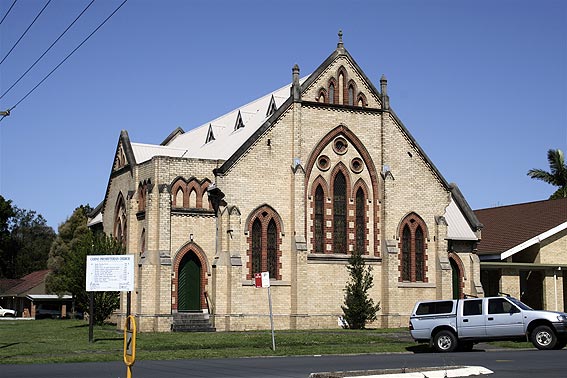
St Paul's Presbyterian Church, Casino
[Photograph by Trevor Bunning (September 2007)]

St Paul's Presbyterian Church, Casino
[Photograph by Trevor Bunning (September 2007)]
Historical and Technical Documentation by Geoffrey Cox
© OHTA 2014, 2015 (last updated November 2015)
Casino originated in 1840 as the 'Crossing Place' where squatters Henry Clay and George Stapleton forded the Richmond River while overlanding cattle and other livestock from Tenterfield. They named their run after Monto Cassino in Italy. The town site was gazetted in 1855, but progress was slow until a railway link was established in 1905.
St Paul's Presbyterian Church was opened on Wednesday 15 July 1908 by the Right Rev. J. Macaulay, Moderator of the General Assembly. Designed by the Casino architects, Messrs Popplewell and Sykes, in the Early English Gothic style, it was described at the time of the opening as follows:
The new edifice, which stands as a lasting monument to the energy and earnestness of the Presbyterians of Casino, was designed and supervised by Messrs Popplewell and Sykes, architects of Casino, and is a magnificent specimen of their ability as architects. It is what is known in the building trade as the "Early English type." ... The building faces Hickey-street, and has an imposing front. It consists of a large triple window of true Gothic shape above which are three bull's eyes, the whole encircled by a large Gothic arch in red brick. Butresses run up each side of this window to the wall top and are there surmounted by pinnacles. The whole front terminates in a wrought stone finial. On either side of the triple window is a double window of Gothic design, faced with red brick. ... On the left hand is the tower entrance [which was never completed].1
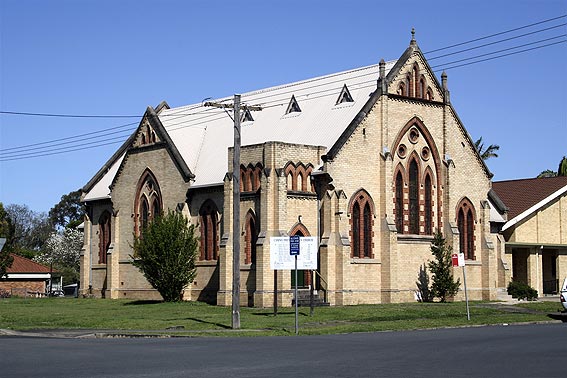
St Paul's Presbyterian Church, Casino,
showing the incomplete tower on the left
[Photograph by Trevor Bunning (September 2007)]
Proposals for a memorial pipe organ arose in 1944:
Proposed Memorial Pipe Organ
CASINO, Thursday. As a memorial to over 100 members of St. Paul's Presbyterian Church, Casino, who are serving in the present War, the committee of management last night decided to proceed with the collection of the amount necessary to provide and install a pipe organ in the church. A special committee consisting of Rev. A. T. P. North and Messrs. A. N. Montgomery, J. McKinnon, C. M. Beale, A. W. R. Jack and M. Kunkler was appointed to collect and receive subscriptions.2
By March 1946, the Pipe Organ Committee was recommending that two additional stops be added to the specification:
New Pipe Organ for Casino St Paul's
CASINO, Monday. St. Paul's Presbyterian Church, Casino, at the annual meeting approved of a recommendation by the Pipe Organ Committee that two additional stops he added to the instrument at a cost of £260. This will bring the cost of the organ, when installed, to £1517. Structural alterations to permit of the organ being placed midway between the two side walls of the church, will cost an additional £150.3
Further progress was announced in March 1947, when it was expected that the organ would be completed within a few months:
Good Progress with New Pipe Organ
CASINO. Sunday. At the annual meeting of the congregation of St. Paul's Presbyterian Church it was disclosed that, after making a payment of £660 on account to the builders of the memorial pipe organ to be installed in the church, meeting the cost of plans for the platform and purchasing war bonds there still remained a balance in the fund of £211; The amount so far subscribed totals £1401 and the estimated cost of the organ is £1360. It is anticipated that the organ, which will be a memorial to those who served in both world wars, will be installed within a few months.4
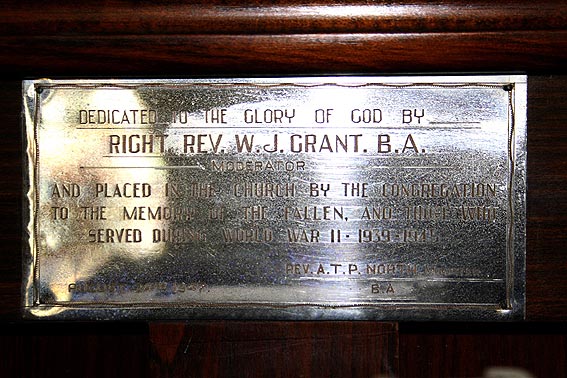
The Memorial Plaque on the organ (August 1947)
[Photograph by Trevor Bunning (September 2007)]
The Whitehouse Bros ledger entry shows that the two additional stops (Sw. Oboe 8ft and Gt. Hohl Flute 8ft) had been added by the time the organ was installed in August 1947:
| 1947 Aug 23 |
Building and erecting complete in St Pauls Pres Church Casino One two-manual & pedal pipe organ as per spec & est dated 23rd May 1944 |
£1075 |
|
Installing extra Stop (OBOE) |
£ 165 |
||
Installing extra Stop (HOHL FLUTE) |
£ 120 |
||
Increased cost of metal pipes |
£ 60 |
||
Increased wage costs |
£ 28 |
||
Increased cost of action parts & materials |
£ 23 |
||
_______ £1471.5 |
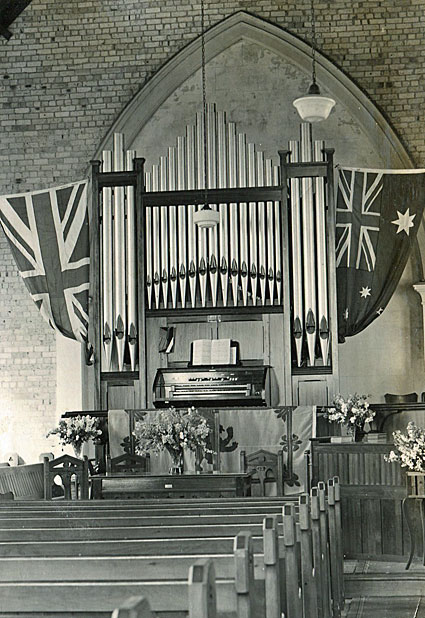
The Whitehouse Bros organ, August 1947
[Photograph from the scrapbooks of Miss Margery Horn]
The organ was dedicated at the morning service on Sunday 24 August 1947 'in memory of those who made the supreme sacrifice and of those who served in the World War II.' An organ recital was given at 3pm together with a musical programme arranged by Mrs J. Tinkler, Mr A. Jack and Mr A. Montgomery.6 A varied recital programme given on the following Tuesday evening 26 August, by Miss Margery Horn of Brisbane with assisting artists, comprised the following works:
• Toccata and Fugue in D Minor - J.S. Bach
• Air (from Orchestra Suite No 3) - J.S. Bach
• Jesu Joy of Man's Desiring - J.S. Bach
• Study in B Minor - Schumann
• Chopin, Nocturne in E flat - Chopin
• Allegro Cantabile (5th Symphony) - Widor
• Solemn Melody - Walford Davies
• Purcell, Trumpet Tune and Air - Purcell
• Melody - Arthur Fox
• Gavotte - Wesley
• Priere et Berceuse - Guilmant.7
Margery Horn went on to give annual recitals at the church around the date of Anzac Day in 1948, 1949 and 1950.8
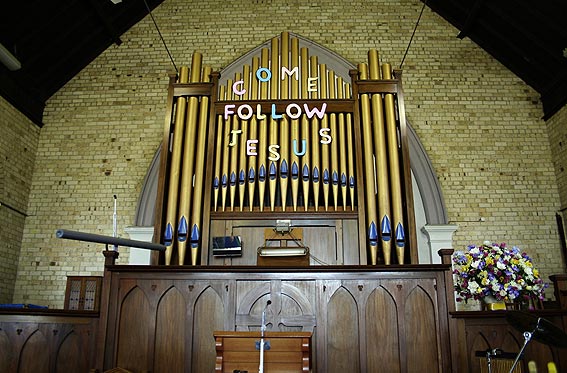
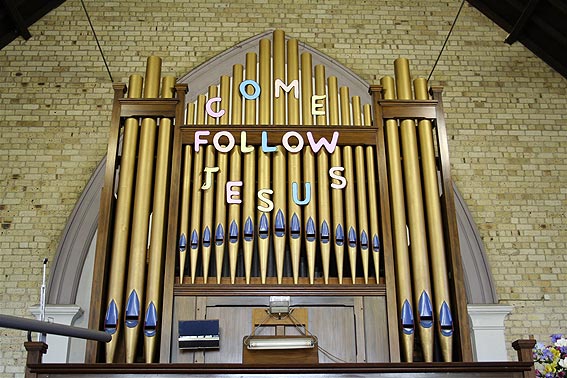

The 1947 Whitehouse Bros organ
[Photographs by Trevor Bunning (September 2007)]
The specification is:
| Great Open Diapason Hohl Flute Salicional Flute Swell Violin Diapason Gedact Salicional Principal Oboe Pedal Bourdon |
8 8 8 4 8 8 8 4 8 16 |
A A |
Couplers
Swell to Great Super
Swell to Great
Great to Pedals
Swell to Pedals
Tremulant
Attached stop-key console
Compass: 61/30
Balanced swell pedal
Tubular-pneumatic action.9
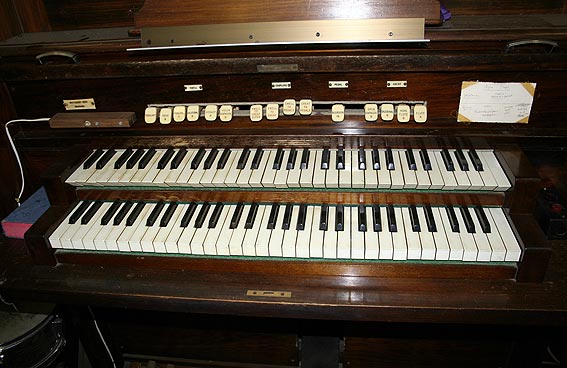


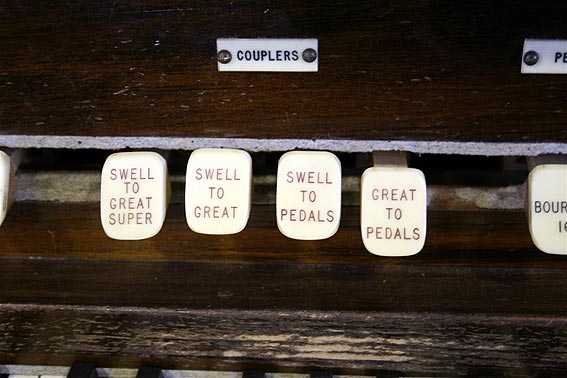
Console details of the 1947 Whitehouse Bros organ
[Photographs by Trevor Bunning (September 2007)]
The specification for both this instrument and the one at the Methodist Church, Morningside had been drawn up in 1944 with 8 speaking stops, although neither was completed until 1947. Apart from the two additional stops provided at Casino, these instruments were identical to the organs for the Methodist Church, Lutwyche (8 stops, 1949), the Methodist Church, Chermside (8 stops, 1950) and the Toowoomba Preparatory School (9 stops, 1949).
This reflected the highly standardised design for pneumatic-action organs built by the firm from the early 1910s onwards. These instruments all used cone-pallet chests and featured 'inclined-block' stop-tabs placed in a row above the upper manual. The duplexing of the Swell string stop on the Great Organ was also a common feature from the early 1930s onwards, and the later instruments such as these used the same name (Salicional) for both stops. The casework was also standardised, with a central flat of 15 pipes, and two side-flats of 3 pipes.
_________
1 Northern Star (Lismore, 18 July 1908), p. 7.
2 Northern Star (Lismore, 25 February 1944), p. 4.
3 Northern Star (Lismore, 12 March 1946), p. 2.
4 Northern Star (Lismore, 10 March 1947), p. 4.
5 Whitehouse Bros Ledger (1940-1954), p. 317.
6 Undated newspaper clipping and 'Memorial Pipe Organ Dedication' programme in the scrapbooks of Miss Margery Horn.
7 The Richmond River Express (26 August 1947), p. 5; The Richmond River Express (27 August 1947), p. 8; The Northern Star (Lismore, 28 August 1947), p. 4, cited in the scrapbooks of Miss Margery Horn.
8 Cited by Phillip Gearing in the scrapbooks of Miss Margery Horn (November 2015).
9 Specification derived from photographs by Trevor Bunning (September 2007).